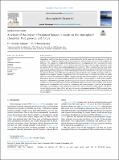Por favor, use este identificador para citar o enlazar a este item:
http://hdl.handle.net/10261/240514COMPARTIR / EXPORTAR:
 SHARE SHARE
 CORE
BASE CORE
BASE
|
|
| Visualizar otros formatos: MARC | Dublin Core | RDF | ORE | MODS | METS | DIDL | DATACITE | |

| Campo DC | Valor | Lengua/Idioma |
|---|---|---|
| dc.contributor.author | Gordillo Vázquez, Francisco J. | es_ES |
| dc.contributor.author | Pérez-Invernón, Francisco J. | es_ES |
| dc.date.accessioned | 2021-05-12T07:53:27Z | - |
| dc.date.available | 2021-05-12T07:53:27Z | - |
| dc.date.issued | 2021-01-04 | - |
| dc.identifier.citation | Atmospheric Research 252: 105432 (2021) | es_ES |
| dc.identifier.issn | 0169-809 | - |
| dc.identifier.other | SEV-2017-0709 | - |
| dc.identifier.uri | http://hdl.handle.net/10261/240514 | - |
| dc.description | This is an open access article under the CC BY-NC-ND license. | es_ES |
| dc.description.abstract | Atmospheric electricity has been intensively studied during the last 30 years after the discovery in 1989 of different forms of upper atmospheric electrical discharges (so–called Transient Luminous Events) triggered by lightning in the troposphere. In spite of the significant number of investigations that led to important new results unveiling how lightning produces a zoo of transient electrical discharges from the upper troposphere to the mesosphere, there is still no clear understanding about how all sort of TLEs – including those that occur inside thunderclouds – can contribute to the chemistry of the atmosphere both at the local and global scale. This review paper aims at presenting a perspective on the TLE atmospheric chemistry research done in the past, in the present as well as to describe some of the challenges that await ahead to find the true scientific importance of the non-equilibrium atmospheric chemistry triggered by TLEs. This review comes to conclude that while the global chemical impact of elves and halos are almost negligible, the large scale chemical impact of sprites, blue jets and blue starters and that of impulsive cloud corona discharges might be non–negligible in terms of their possibly measurable contribution to important greenhouse gases such as ozone and nitrous oxide (N2O). Being the third strongest greenhouse gas (after carbon dioxide and methane) and by having the ability to deplete ozone, precise determination of atmospheric N2O sources is of increasing and pressing demand. A new era in atmospheric electricity is just emerging in which dedicated scientific space missions (ISS–LIS, ASIM) together with geostationary lightning sensors (since 2016) and new micro–scale and parameterizations of TLEs in general atmospheric chemistry circulation models will hopefully help to start clarifying the full role of TLEs in the chemistry of the atmosphere. © 2020 The Author(s). | es_ES |
| dc.description.sponsorship | This work was supported by the Spanish Ministry of Science and Innovation (AEI) under projects ESP2017-86263-C4-4-R, PID2019-109269RB-C43 and the FEDER program. FJPI acknowledges the sponsorship provided by the Federal Ministry for Education and Research of Germany through the Alexander von Humboldt Foundation. FJGV acknowledges financial support from the State Agency for Research of the Spanish MCIU through the “Center of Excellence Severo Ochoa” award for the Instituto de Astrofísica de Andalucía (SEV-2017-0709). | es_ES |
| dc.language.iso | eng | es_ES |
| dc.publisher | Elsevier | es_ES |
| dc.relation | info:eu-repo/grantAgreement/MINECO/Plan Estatal de Investigación Científica y Técnica y de Innovación 2013-2016/ESP2017-86263-C4-4-R | es_ES |
| dc.relation | info:eu-repo/grantAgreement/AEI/Plan Estatal de Investigación Científica y Técnica y de Innovación 2017-2020/PID2019-109269RB-C43 | es_ES |
| dc.relation | info:eu-repo/grantAgreement/MINECO/Plan Estatal de Investigación Científica y Técnica y de Innovación 2013-2016/SEV-2017-0709 | es_ES |
| dc.relation.isversionof | Publisher's version | es_ES |
| dc.rights | openAccess | es_ES |
| dc.subject | TLEs | es_ES |
| dc.subject | Atmospheric chemistry | es_ES |
| dc.subject | Lightning | es_ES |
| dc.subject | Streamers | es_ES |
| dc.subject | Cloud corona discharges | es_ES |
| dc.subject | Greenhouse gases | es_ES |
| dc.subject | Imaging | es_ES |
| dc.subject | Spectroscopy | es_ES |
| dc.subject | Modeling | es_ES |
| dc.title | A review of the impact of transient luminous events on the atmospheric chemistry: Past, present, and future | es_ES |
| dc.type | artículo | es_ES |
| dc.identifier.doi | 10.1016/j.atmosres.2020.105432 | - |
| dc.description.peerreviewed | Peer reviewed | es_ES |
| dc.relation.publisherversion | https://doi.org/10.1016/j.atmosres.2020.105432 | es_ES |
| dc.rights.license | https://creativecommons.org/licenses/by-nc-nd/4.0/ | es_ES |
| dc.contributor.funder | Ministerio de Ciencia e Innovación (España) | es_ES |
| dc.contributor.funder | European Commission | es_ES |
| dc.contributor.funder | Federal Ministry of Education and Research (Germany) | es_ES |
| dc.contributor.funder | Ministerio de Ciencia, Innovación y Universidades (España) | es_ES |
| dc.contributor.funder | Agencia Estatal de Investigación (España) | es_ES |
| dc.relation.csic | Sí | es_ES |
| oprm.item.hasRevision | no ko 0 false | * |
| dc.identifier.funder | http://dx.doi.org/10.13039/501100002347 | es_ES |
| dc.identifier.funder | http://dx.doi.org/10.13039/501100004837 | es_ES |
| dc.identifier.funder | http://dx.doi.org/10.13039/501100000780 | es_ES |
| dc.identifier.funder | http://dx.doi.org/10.13039/501100011033 | es_ES |
| dc.type.coar | http://purl.org/coar/resource_type/c_6501 | es_ES |
| item.grantfulltext | open | - |
| item.fulltext | With Fulltext | - |
| item.openairecristype | http://purl.org/coar/resource_type/c_18cf | - |
| item.languageiso639-1 | en | - |
| item.cerifentitytype | Publications | - |
| item.openairetype | artículo | - |
| Aparece en las colecciones: | (IAA) Artículos | |
Ficheros en este ítem:
| Fichero | Descripción | Tamaño | Formato | |
|---|---|---|---|---|
| 2021AtmRe.25205432G.pdf | 18,12 MB | Adobe PDF |  Visualizar/Abrir |
CORE Recommender
SCOPUSTM
Citations
22
checked on 19-may-2024
WEB OF SCIENCETM
Citations
21
checked on 26-feb-2024
Page view(s)
77
checked on 22-may-2024
Download(s)
201
checked on 22-may-2024
Google ScholarTM
Check
Altmetric
Altmetric
Este item está licenciado bajo una Licencia Creative Commons

